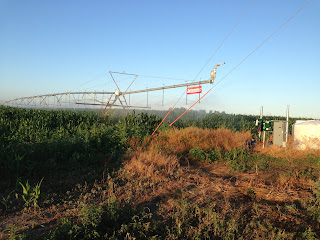 Farming in the middle of Nebraska we need to irrigate if we hope to raise a normal crop every year. The picture at left shows the difference between irrigated and dryland.
Farming in the middle of Nebraska we need to irrigate if we hope to raise a normal crop every year. The picture at left shows the difference between irrigated and dryland.We have two different water sources, surface and ground. Surface water is diverted out of a river or stream and then transported to the fields by canals or pipe. Our water comes from the Platte River and is brought to our farm by the Dawson County Canal. It is the third oldest canal in Nebraska and was dug with horses and mules about 1894.
At right you are looking down the canal north of our house. It is already half the size it was at the river 12 miles upstream. The Platte River falls 6 feet every mile it moves east. The canals were designed to fall 1 foot every mile. This way the canal moves away from the river as it moves east.
Ground water is water taken from the ground (simple huh?). Our ground water comes from the Ogallala Aquifer, one of the largest fresh water aquifers in the world. We are very fortunate to have a very thick water supply that is also close to the surface. We hit water about 10 feet down and the water bearing sand and gravel is about 200 feet thick. This a picture of our newest well, drilled 3 years ago. We do have limitations on drilling new wells, they can only replace old wells.
We use three different ways to deliver the water to the plants in the field now. My father used two others in previous decades, but newer methods are more efficient. The "oldest" method we currently use is gated pipe. This is either aluminum or plastic pipe that is 8-10" in diameter. There are rectangular holes cut in one side and plastic gates inserted to plug the holes.
Every summer around July 1 we have to string out the pipe on the ends of the fields. I usually recruit some high school kids to help. The pipes are 30' feet long and we put out about 5 miles of pipe so that is a lot of pipe.

This a picture of the water coming out of the open gates. When we are irrigating we have to go to each field and open a new set of rows and close the old rows twice a day. We use old golf putters to tap the gates open and closed. Saves a lot of sore backs.
We use gated pipe on both surface and ground water. Most fields we have a pump on the surface water to pressurize it for the gated pipe. Some fields have enough gravity drop to work without a pump.
Each fall we must remember to flush the gated pipe that is on surface water. There is sediment in the water that settles out in the pipe. The picture at right is just after I pulled the plug. It will flush for several hours before the water starts running clear. If we don't the pipes will have enough mud in them to make it almost impossible to pick up in the fall.
After the last irrigation (and flush) we pull the pipes apart and then find another crew of strong backs to pick all the pipe back up and pile it for next year.
We started using gated pipe in 1975 and until a few years ago that was all we used. Then I purchased a couple of center pivot irrigation systems (left). The look like a pipe in the air with wheels underneath. One end is fastened to a pivot point and the other end moves around the field in a circle. They have sprinklers on them similar to ones in your yard, put more precise.
A new center pivot system is about $75,000 to $100,000 depending on what you add to the package. Normally they need little daily attention, other than to make sure they are still running. We have ours set up to send a text message to our phone if something happens to it. We also have an app to control the pivot from wherever we are. They are more efficient in using water than the gated pipe and take much less labor. Much of the land previously irrigated with gated pipe is being converted to pivots in our area if they fit the field. One downside is that pivots irrigate a circle in a square field so there are corners that will be dryland or will have to be irrigated another way.
The newest irrigation technology is subsurface drip irrigation (SDI). It has been used in orchards and other high value crops for several years, but is now finding a foothold in rowcrops here. I installed this system 3 years ago and am very happy. It is about twice as expensive as a full center pivot on a per acre basis, but if your field is small, rectangular or irregular shaped, it may be about the same price per acre.
This picture shows the valves that control which sections of the field get water. I am currently adding a computer controller to my system so that it can be controlled remotely.
Normally we finish irrigating by Labor Day, but not this year. We will be irrigating until September 14 at least. The crops got behind with some cool weather in August and are not mature yet. If we stop irrigating too soon the plants die early and the yield drops off dramatically.






No comments:
Post a Comment